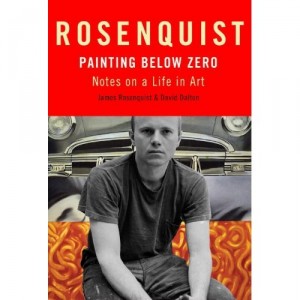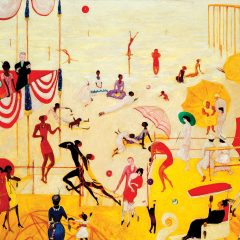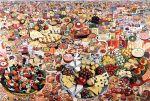Post by Judith Stein
If you have ever wondered about creativity and the zeitgeist, you will enjoy James Rosenquist’s new autobiography, Painting Below Zero, Notes on a Life in Art. It is a richly colored account of one artist’s trajectory from the fifties to the present day, an engaging narrative that tracks his transformation from American country boy to international art star.
In 1955, the twenty-one year old Rosenquist moved to New York from Minneapolis to study at the Art Students League. By 1960, he was supporting himself as a master billboard painter, a member of the Sign, Pictorial and Display Union, Local 230. He worked in a studio in lower Manhattan, in the fabled artists’ neighborhood of Coenties Slip where Jack Youngerman, Ellsworth Kelly, Agnes Martin, Robert Indiana, Lenore Tawney, Robert Rauschenberg, Jasper Johns, Barnett Newman, and the poet Oscar Williamson also lived. When two union brothers accidentally plunged to their death from their scaffolding, he quit his day job and concentrated on finding himself as an artist.
The Rosenquist we know and love, today seventy-five, took time to arrive at his signature Pop style. By the early 1960s, the art climate was changing: “anti splash was in the air.” A new interest in crisp edges, emotional restraint and ironic content was crowding out Abstract Expressionism’s juicy strokes and evident emotions. Rosenquist’s descriptions of negotiating this changeover are some of his autobiography’s unique attractions. In the late fifties and early sixties, he aspired towards abstraction: ”Everyone was trying to get to zero with abstract painting.” When he decided to make objects and images, he felt he had reached “below zero,” hence the title of the book.
Rosenquist called on his commercial experience working on a colossal scale, where everything seemed abstract because he could never step back far enough to take in the whole picture while he was painting it. In his studio, he first assembled collages of advertisements from vintage magazines. He then enlarged them on canvas to create paintings with mysterious, poetic—and political—juxtapositions of images. His compositions had veiled, metaphoric content but used components that were easy to read.
That not everyone grew to appreciate Rosenquist the Pop artist is brought home by a marvelous anecdote from 1980. Frank Borman, the former astronaut and then president of Eastern Airlines, testily vetoed Rosenquist‘s forty-six foot ”Star Thief” mural for the Eastern Airlines terminal at the Miami International Airport. It seems that when Borman saw Rosenquist’s gigantic depiction of bacon strips floating in outer space, he fumed that the artist was wildly mistaken—he himself had been around the moon ten times and could certainly attest he had never seen any bacon up there. No matter. The canny artist later sold it to someone else.
Large portions of Rosenquist’s Painting Below Zero open a window for us to learn how and when ideas came to him and what he did with them. It is rare for any artist to reveal the genesis of individual paintings, but Rosenquist lets us in on what he was thinking when he first envisioned them in his mind’s eye. Just don’t take his word on matters of fact. Alfred A. Knopf’s copy editors should have caught a multitude of art historical errors. Here are a few examples: Thomas Eakins did not study at the Art Students League but at the Pennsylvania Academy of Fine Arts; Arshile Gorky and Hans Hofmann were not among the European artists who first came to the US during WW II; they arrived in 1920 and 1933, respectively; and surely Fifth Avenue could not have been taken up by “nothing but horses and carriages” in the 1930s. Perhaps Rosenquist’s most endearing gaffe concerns the bellwether, 1960 exhibition New Forms, New Media. He recalls that it took place at the Michael Jackson Gallery, a slip that is likely causing the late Martha Jackson to moonwalk on her grave.
Sometimes Rosenquist’s text is notable for what it doesn’t say. For example, he talks about going to Europe in 1964for his first show abroad, held at Ileana Sonnabend’ s gallery in Paris. He describes a side trip to Venice that summer, where he found a hotel for his parents for $1.80 a night. Fair enough for nostalgic trivia, but he mentions not a word about the historic exhibition he must have seen at that year’s Venice Biennial, when his close friend Bob Rauschenberg took the international grand prize, the first modern American to win it. In another instance, when Rosenquist gives minimal mention to his tragic automobile accident that seriously injured his wife and son in 1972, I had the impression that crucial comments were left unsaid.
Rosenquist, a colorful raconteur, has been regaling listeners for years. It is to the credit of his literary collaborator David Dalton that the artist’s stream-of-consciousness monologues have been shaped into a generally coherent narrative. And what funny tales it encompasses. Rosenquist describes an incident he observed at the Green Gallery, the gallery that launched his career early in 1962. He watched as the collector Morton G. Neumann picked up and tucked into his pocket a life-size soft sculpture by Claes Oldenburg of a string of sausages. When Neumann let director Dick Bellamy know that he wanted to buy it, Bellamy told him it was already sold. But the collector wouldn’t take no for an answer. They tussled back and forth, and finally Bellamy had to reach over and pull the sausages out of Neumann’s jacket.
There is a hilarious account of the time Rosenquist met Salvador Dali for a drink. When the waiter asked what he would like to have, Rosenquist replied “a screwdriver.” The Spaniard, unfamiliar with American mixology, interpreted his response as a non sequitur, a brilliantly surreal riposte. Too, readers can share the author’s schadenfreudic asides. In a paragraph about Rauschenberg, he detours to mention the sorry case of New York real estate mogul Jack Klein, who once when drunk, fell into a cactus plant and had to have hundreds of spines removed with a pliers.
It is understandable, if odd, that in a few instances Rosenquist quotes himself being quoted by others in interviews that occurred years ago. Our memories are fallible, losing their freshness the more we tap them. The longer we live, the more the details of the past can shift and blur. Yet eye witness narratives are a boon to art historians, who must paw through the past in an attempt to reconstruct and to understand what actually happened. All told, Rosenquist’s Painting Below Zero makes captivating reading for art lovers and art specialists alike.
Painting Below Zero: Notes on a Life in Art
by James Rosenquist with David Dalton
New York, Alfred A. Knopf, 2009
384 pages Hardcover
ISBN-10: 0307263428
–Judith Stein is a Philadelphia-based writer at work on a biography of the late art dealer Dick Bellamy, “the eye of the sixties.”










